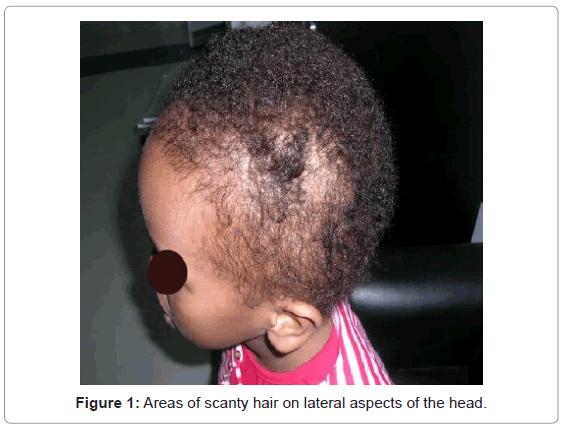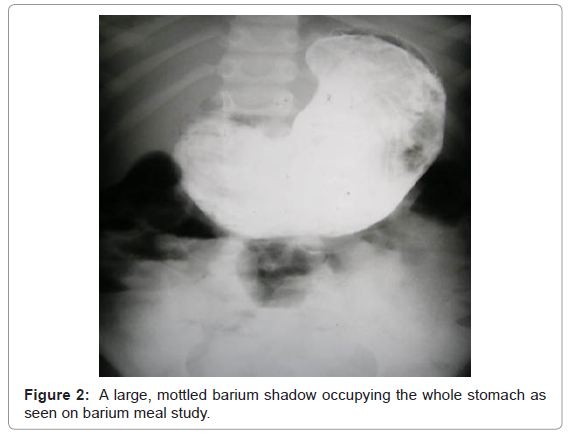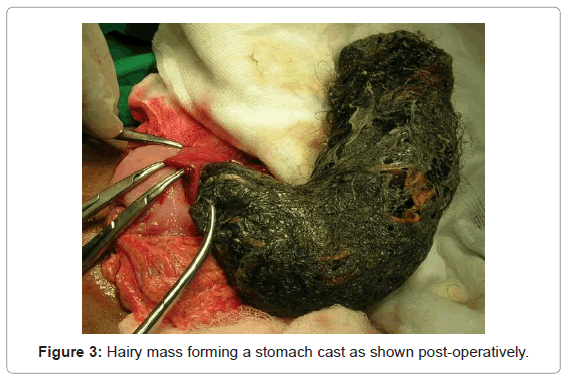Case Report Open Access
Trichobezoar: A Rare Cause of Gastric Outlet Obstruction in Children
Gormallah Alghamdi1, Yasen Alalayet2 and Abdulrahman Al-Hussaini3*
1Children’s Hospital, Children’s Hospital, King Saud Medical City, Riyadh, Saudi Arabia
2Pediatric Surgery Department, King Saud Medical City, Riyadh, Saudi Arabia
3Division of Gastroenterology, Children’s Hospital, King Fahad Medical City, Riyadh, Saudi Arabia
- *Corresponding Author:
- Abdulrahman Al-Hussaini
Division of Pediatric Gastroenterology
University of King Saud for Health sciences
Hepatology & Nutrition
Children’s Hospital, King Fahad Medical City
PO box 59046, Riyadh Postal code 11525
Kingdom of Saudi Arabia
Tel: +966-12889999
Fax: +966-12070039
E-mail: aa_alhussaini@yahoo.com
Received date: March 29, 2013; Accepted date: May 01, 2013; Published date: May 04, 2013
Citation: Alghamdi G, Alalayet Y, Al-Hussaini A (2013) Trichobezoar: A Rare Cause of Gastric Outlet Obstruction in Children. J Gastroint Dig Syst S3:005.. doi: 10.4172/2161-069X.S3-005
Copyright: © 2013 Alghamdi G, et al. This is an open-access article distributed under the terms of the Creative Commons Attribution License, which permits unrestricted use, distribution, and reproduction in any medium, provided the original author and source are credited.
Visit for more related articles at Journal of Gastrointestinal & Digestive System
Abstract
A bezoar is an accumulation of exogenous matter in the stomach or intestine. Trichobezoars is composed of patient’s own hair and is rare in children. The condition is usually associated with mentally retarded children and may be caused by a variety of conditions, including anxiety, depression, and family stress. It also may be seen in normal-functioning adults. Here we describe a nine-year old girl with huge gastric trichobezoar causing gastric outlet obstruction.
Keywords
Trichobezoar; Gastric outlet obstruction; Trichotillomania; Child
Introduction
A bezoar is an accumulation of exogenous matter in the stomach or intestine. Trichobezoars is composed of patient’s own hair and is rare in children. Hair pulling, or trichotillomania, is the abnormal desire to pull out one’s own hair. The condition is usually associated with the mentally retarded or with young children and may be caused by a variety of conditions, including anxiety, depression, and family stress. It also may be seen in normal-functioning adults. Here we describe a nine-year old girl with huge gastric trichobezoar causing gastric outlet obstruction.
Case Report
A nine year old Saudi girl presented to our hospital with history of abdominal pain, and fullness for four months, associated with occasional non bilious, non bloody vomiting. These symptoms are associated with a decrease of appetite and poor weight gain. The child had no history of diarrhea, night sweat, cough, urinary symptoms, and allergy or drug ingestion. She was observed to ingest her own hair. She is in primary school with an average performance and of middle social class family.
On physical examination, her weight and height are at 50th centile for age. Vital signs were normal. She was pale but not jaundiced, with a scanty hair on lateral aspects of the head (Figure 1). The abdomen was soft, with large non tender, non compressible and non mobile firm mass in the epigatrium extending to right hypochondrium. The mass has smooth surface, rounded borders with no bruit. Liver is 1cm below right costal margin and no splenomegaly. Other systemic examination was unremarkable.
Laboratory tests were notable for microcytic hypochromic anemia with a hemoglobin concentration of 5.5 gm/dL (normal range, 11.5- 14 gm/dl), Leukocyte count 16.0/cumm, Platelet count 760 × 109/L (normal range, 150-450 109/L) and normal coagulation profile. Serum iron level is 2 umol/L (normal range 14-23 umol/L) and serum iron binding capacity is (90 umol/L) (normal range 20-70 umo/L). Other blood tests including urea, electrolytes and liver function tests were normal. Plain abdominal X-ray demonstrated a soft tissue mass occupying central upper abdomen with extension to the right side with no evidence of calcification. Ultrasound of Abdomen showed a well defined hyper echoic mass with acoustic shadow in the epigastric region. Barium meal study revealed a highly distended stomach with a large filling defect with some contrast penetration through it (Figure 2). Imaging studies are consistent with diagnosis of bezoar.
Since the bezoar has a very large size, the patient underwent surgery. A hard, hairy, mass, mixed with food particles, measuring 30x15 cm was removed in one piece (Figure 3), with uneventful postoperative course. She was prescribed Iron supplements and assessed by a psychologist who advised a short hair style, in order to reduce the provoked course.
Discussion
A bezoar is an accumulation of exogenous matter in the stomach or intestine. Hair pulling may be caused by a variety of condition, including anxiety, depression, and family stress. Child often receives much attention for hair pulling, which in turn strengthens the urge to engage in the act. In some children, hair pulling can become a very strong, compulsive habit.
Most bezoars have been found in females with underlying personality problems or in neurologically impaired individuals. The peak age of onset of symptoms is the second decade of life. Bezoars are classified on the basis of their composition. Trichobezoars are composed of the patient’s own hair, and phytobezoar are composed of a combination of plant and animal material [1,2]. Lactobezoars were previously found most often in premature infants and may be attributed to the high casein or calcium content of some premature formulas [1-3].
The genesis of bezoars may follow impaired gastric emptying as in post gastric vagotomy, antral resection, gastroparesis of any reason, or gastric outlet obstruction [4,5]. Poor mastication and the ingestion of large quantities of indigestible solids may precipitate bezoar formation [5].
Trichobezoars can become large and form cast of the stomach. They may enter into the proximal duodenum as occurred in our case, to present with symptoms of gastric outlet or partial intestinal obstruction including vomiting, anorexia, and weight loss [1,2]. Patients may complain of abdominal pain, distension, and severe halitosis.
Patients may occasionally have iron deficiency anemia, hypoproteinemia or steatorrhea caused by an associated chronic gastritis, protein losing enteropathy and pancreatitis. Physical examination may demonstrate patchy baldness and a firm mass in the right upper quadrant. Only two cases of gastric trichobezoar in children have been reported from Saudi Arabia [6-8], possibly because of the under-recognition of this clinical entity. Therefore symptoms could develop for several months or years before reaching a diagnosis.
An abdominal plain film may suggest the presence of a bezoar which can be confirmed by barium or ultrasound examination. Unlike phytobezoar, which is generally impervious to barium, trichobezoars tend to absorb barium, adding in the radiological diagnosis [1,2]. Endoscopy provides a diagnosis and a possible mean of therapeutic disruption and removal of material [8].
The treatment of bezoars should be tailored to their composition. Lactobezoars usually resolve when feeding is withheld for 24-48 hours [1,2]. Trichobezoars are resistant to enzymatic dissolution, and must be removed endoscopically or surgically [8]. Operative removal is usually indicated for large trichobezoar [9]. Gastroscopic removal carries some risks such as perforation or intestinal obstruction. After a bezoar is removed, a plan should be developed to prevent recurrence by modifying if possible any obstruction, correction of dietary routine, or addition of prokinetic agents.
Psychological assessment and support is very important in the evaluation of a child with bezoar. Therapy of hair pulling includes behavior modification and family or individual counseling. Until the underlying causes for the condition are cleared up, the only solution is to keep the hair too short for pulling.
In conclusion, a diagnosis of gastric bezoar should be suspected in any child with symptoms of gastric outlet obstruction, and surgical removal is usually indicated for large trichobezoar.
References
- Byrne WJ. Bezoars 315,1, Nelson Textbook of pediatrics -17th Edition -1244.
- Byrne WJ (1994) Foreign bodies, bezoars, and caustic ingestion. Gastrointest Endosc Clin N Am 4: 99-119.
- Usmani SS, Levenbrown J (1989) Lactobezoar in a full-term breast-fed infant. Am J Gastroenterol 84: 647-649.
- Ebener B, Herzog P, Klose K, Grönniger J, Schmidt HD, et al. (1983) Postvagotomy complications: stomach bezoars - case report and review of the literature. Z Gastroenterol 21: 220-227.
- Feldman: Slesenger & Fordtran’s Gastrointestinal and Liver Disease, (6thedn). Copyright © 1998 W.B.Saunders Company.
- Al-Skaini MS, Seleem MI (2000) Trichobezoar: a rare cause of acute bowel obstruction. Saudi Med J 21: 585-586.
- Alam M, Khan D (2002) An anemic patient who presented with abdominal pain due to trichobezoar. Saudi Med J 23: 1139-1140.
- Dumonceaux A, Michaud L, Bonnevalle M, Debeugny P, Gottrand F, et al. (1998) Trichobezoars in children and adolescents. Arch Pediatr 5: 996-999.
- Sood AK, Zaheer S, Drugs GT (2000) Childhood Trichobezoars: case report and literature Review. Indian J Pediatr 67: 390-391
Relevant Topics
- Constipation
- Digestive Enzymes
- Endoscopy
- Epigastric Pain
- Gall Bladder
- Gastric Cancer
- Gastrointestinal Bleeding
- Gastrointestinal Hormones
- Gastrointestinal Infections
- Gastrointestinal Inflammation
- Gastrointestinal Pathology
- Gastrointestinal Pharmacology
- Gastrointestinal Radiology
- Gastrointestinal Surgery
- Gastrointestinal Tuberculosis
- GIST Sarcoma
- Intestinal Blockage
- Pancreas
- Salivary Glands
- Stomach Bloating
- Stomach Cramps
- Stomach Disorders
- Stomach Ulcer
Recommended Journals
Article Tools
Article Usage
- Total views: 18884
- [From(publication date):
specialissue-2013 - Nov 08, 2025] - Breakdown by view type
- HTML page views : 14207
- PDF downloads : 4677



